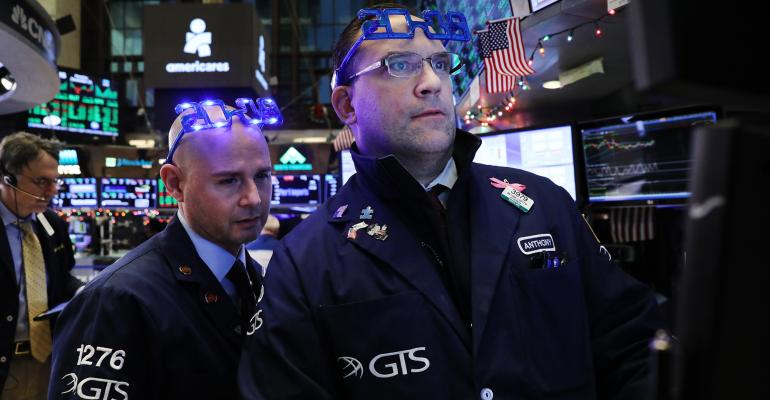Though the $313 billion of net inflows for the exchange traded funds industry in 2018 was down from the $466 billion a year earlier, CFRA thinks the cash haul was impressive as most major market indexes tracked by these funds were flat or down. Rather than just chasing strong performance, investors have increasingly gained comfort in the typically lower-cost and index-based ETF approach.
In 2018, investors added $213 billion to equity ETFs, with broad asset allocation products helping fill demand. iShares Core S&P 500 ETF (IVV), the second largest ETF, added $19 billion of assets, despite declining 4.5 percent in value; the similarly low-priced Vanguard 500 ETF (VOO) pulled in $14 billion of its own.
Aided by growing interest during the fourth quarter, the $28 billion of new money value ETFs gathered doubled the inflows of growth products in 2018. Yet, the 0.1 percent decline for SPDR S&P 500 Growth (SPYG) was narrower than the loss for the broader large-cap index, but easily outperformed the 9 percent decline for SPDR S&P 500 Value (SPYV).
Tactical investors put $14 billion into sector-focused ETFs last year, with information technology and health care leading the way. The 2,400-basis point spread between the best and worst performing of the S&P 500 sectors highlights the benefits of getting those calls right. Health Care Select Sector SPDR (XLV) rose 6 percent, easily outperforming the 18 percent decline for the Energy Select Sector SPDR (XLE). As a group, energy ETFs had only approximately $150 million of net inflows.
While the gap between health care and energy might seem wide, according to Sam Stovall, chief investment strategist at CFRA, since 1970 the average difference between the returns for the best and worst S&P 500 sectors was 4,100 basis points. In the year after recording a below-average differential, the S&P 500 posted a positive full-year total return 91 percent of the time. Stovall suggests that history indicates this could help 2019 be a year back in the black for the well-known U.S. benchmark. (Of course, past performance is not a reliable indicator of future results.)
Outside of the U.S., demand for well-diversified, low-cost ETFs remained strong even though the losses were sizable. iShares Core MSCI EAFE (IEFA) and iShares Core MSCI Emerging Markets (IEMG) added a combined $36 billion of new money. Yet the developed markets of IEFA lost 14 percent in value and its emerging market iShares sibling declined 15 percent. Though the returns were similar for Vanguard’s international equity duo in 2018, interestingly the flows were different. Vanguard FTSE Developed Markets ETF (VEA) pulled in $9 billion new money, nearly half of IEFA, but Vanguard FTSE Emerging Markets (VWO) had $273 million of net outflows. Despite similar names, investors should be mindful that VWO has no exposure to South Korean equities, while IEMG has a 14 percent weighting in this country.
To CFRA, the biggest ETF flows trend was in fixed income, which pulled in $97 billion of new money in 2018, equal to a 31 percent share of net inflows, even as the Federal Reserve raised interest rates multiple times. While ETFs remain known for tracking indexes such as Bloomberg Barclays Aggregate Bond Index, which was flat in 2018, actively managed fixed income ETFs gathered $21 billion of new money. This was equal to the total inflows for the investment approach between 2015 and 2017.
With Fed rate hikes on the mind, ultra-short and short-term bond funds designed to reduce interest rate sensitivity and yet generate some income were most popular. JPMorgan Ultra-Short Income ETF (JPST) and PIMCO Enhanced Short Maturity Active ETF (MINT) added $5.0 billion and $4.3 billion, respectively, aided by strong 2.2 percent and 1.7 percent gains. In contrast, iShares Core Aggregate Bond ETF (AGG), up only 0.1 percent for the year, added $5.6 billion of new money.
As a group, government bond ETFs were the top asset gatherers with $55 billion, led by iShares Short Treasury ETF (SHV), which has duration of less than half a year and attracted $13 billion in inflows in 2018.
The strong collective inflows for bond ETFs occurred even as many corporate bond funds were out of favor. Heavyweights iShares iBoxx Investment Grade Corporate Bond ETF (LQD) and SPDR Bloomberg Barclays High Yield Bond ETF (JNK) shed $6.8 billion and $5.2 billion, respectively. In contrast, the less rate-sensitive iShares Floating Rate Bond ETF (FLOT) added $4.8 billion of new money.
For perspective, according to Bloomberg, mutual funds had $98 billion of net outflows as of Nov. 2018, with most of the bleeding occurring in equity mutual funds. As 2019 kicks off, we think investors will continue to seek out ETFs to serve both their asset allocation and more tactical needs.
I’ll be joined by Sam Stovall and CFRA Investment Strategist Lindsey Bell for a 2019 Outlook webinar on Wednesday Jan. 9 at 11 a.m. ET. To register, visit https://t.co/pAYL1kTgYY.
Todd Rosenbluth is the director of ETF and mutual fund research at CFRA. Learn more about CFRA’s ETF research here.





